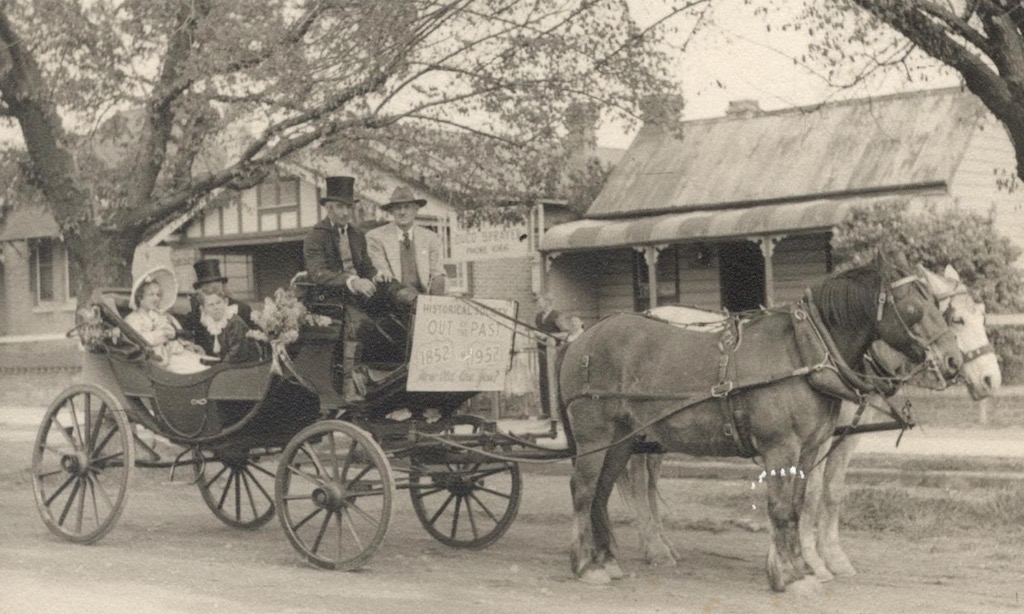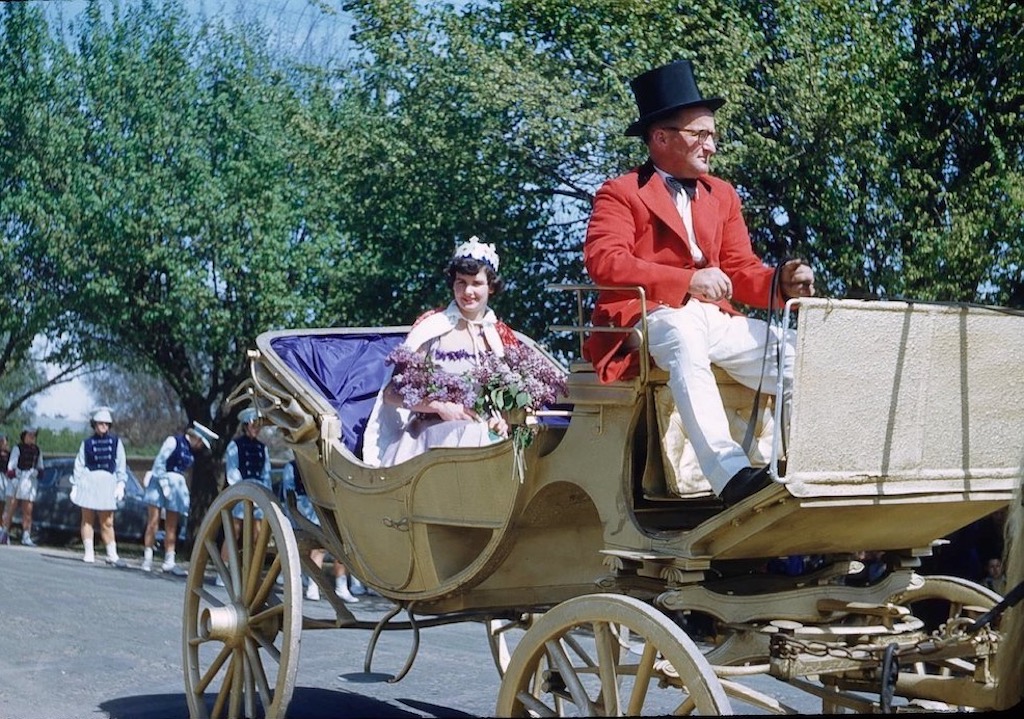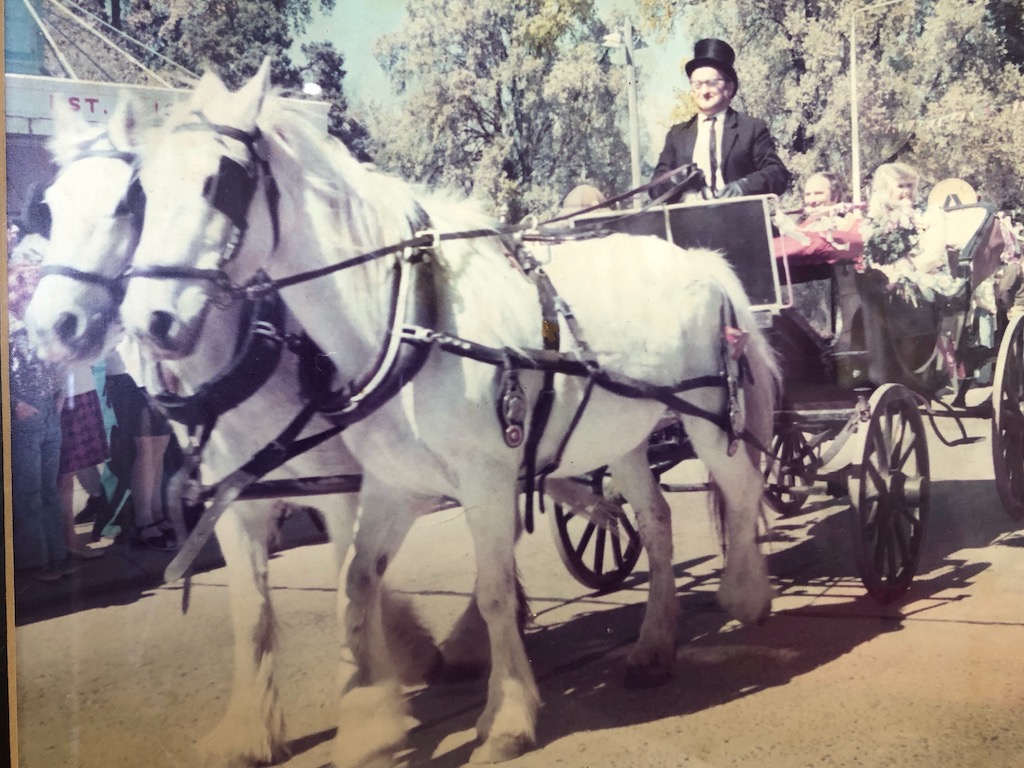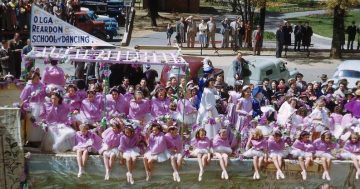
Off to the 1952 Lilac Time Festival and dressed in period costume for the occasion, Stuart Hume jnr recalls being given a 1777 blunderbuss (horse pistol) to hold. It can be seen just above the carriage door. His sisters and brother, Ingrid, Patrick and Jennifer, are also in the prestigious carriage. Sid Hamond drove the carriage and is seated next to Stuart Hume. Photo: Hume family collection.
In the early 1950s when the Lilac Time Festival gathered prestige and raised thousands of pounds for a new hall, the festival’s queen rode in an original Victorian-era carriage in the main-street procession.
The vehicle came from the family of Stuart Hume of Garroorigang, a historic home on the southern fringe of Goulburn, who says the formal term for the carriage was a barouche – a French term for an open vehicle traditionally used for more formal occasions or outings in the 19th century.
Pulled by two horses and with seating for four passengers, it featured a folding leather hood that could be raised to protect the passengers, presumably the ladies, seated in the rear seat facing forward. The two rearward-facing seats, presumably for the gentlemen, had no such protection.
The Garroorigang carriage is a classic example of the type. It was made in Oxford, England, before 1860 by J and T Northe and was brought out to Australia in 1860 by a Captain Lamb assigned on military service to NSW. When Lamb returned to England in 1864 on completion of his posting in Sydney, he sold the carriage to Harborne Belcher, who ran a boarding school for boys at Garroorigang, on Goulburn’s southern outskirts.
Garroorigang first opened in 1857 as the Mulwaree Inn before later becoming Belcher’s private school “for the sons of gentlemen” and was his home.
Belcher, who was related to the Humes, used the carriage regularly until about 1915 when it was replaced by modern transport and stored in the carriage room in the homestead stables. It remained there in its original intact condition for the next 40 years.

Joan Small, the 1952 Lilac Time Festival Queen, was employed by Knowlman’s Store and raised 1005 pounds for the festival. Jan McInnes, whose father, Bob Mote, took the photo, says it may have been taken in 1953 when Joan was the reigning queen and the carriage was painted gold. The driver is Allan Friend. Photo: Bob Mote.
The Lilac Time Festival was founded in 1951. Goulburn historian and founding member of the Goulburn Historical Society, Stuart Hume (Stuart junior’s father), entered the carriage in the Lilac Time procession in 1952. Riding in the carriage at the time with the lamp holders stuffed with lilac blooms were his four children, Ingrid, Patrick, Jennifer and Stuart Jnr, dressed in period costumes. Sid Hamond drove the carriage with Stuart Hume seated beside him.
In subsequent years and as Lilac Time grew into a major community event with increasing pomp and ceremony, the carriage was lent regularly to the festival committee to carry the queen in the procession. It can be seen in many of the surviving video and films from the festival’s heyday. It is not known when it ceased to be used for the queen.
Originally black, at some stage it was painted gold – to add to the pomp and ceremony, no doubt.
“When it was overhauled by an expert in Junee in about 1975, it was repainted in what the expert told us was one of the traditional colours for a barouche,” Stuart said.
Following restoration work, the carriage returned to Garroorigang where it remains today, an integral part of the historic home’s original artifacts and an evocative reminder of life in a more gracious period.

Allan Friend driving the carriage in the Lilac Time Festival, possibly in the 1960s. Allan was a milkman who used horse-drawn vehicles from 1937 to 1973. Photo: Friend family collection.
Tour groups, historical societies, gardening and Probus clubs and private visitors continue calling at Garroorigang from a wide area to see historic photographs, sporting memorabilia and the school room.
“All the furniture in the house is original from the Victorian period in the principal rooms,” Stuart said.
“What blows people away is the place is still in the condition intact as a family home. We live in it, in its original condition. It is basically a snapshot of life over the last 150-odd years.”








